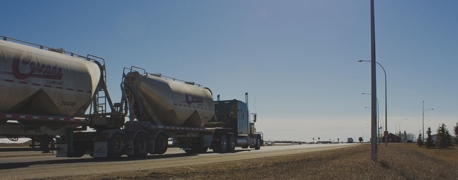7 Things You Didn’t Know About Commercial Trucks & the People Who Drive Them

Sharing the road with a large truck might make you nervous. These vehicles are immense, may weigh up to 80,000 pounds or more, and often carry heavy or potentially hazardous cargo. But, they are also essential to the economy and our way of life. The trucking industry is responsible for transporting nearly 11.5 billion tons of cargo in the United States every single year. This amounts to 80% of all freight deliveries in the country.
Trucks transport everything from mail to medicine to heavy machinery throughout America, making it possible for every person and business to get what they need to survive. The people responsible for driving these trucks face unique challenges and pressures that go beyond dealing with traffic, bad weather, and time away from their families.
Here, we hope to shed light on a few of the things most people don’t know about commercial trucks and the men and women who drive these vehicles to keep the world moving.
Truckers Have the Lowest Drunk Driving Rate of All Motorists
According to traffic accident statistics from the Federal Motor Carrier Safety Administration (FMCSA), truck drivers have the lowest drunk driving rate of all motorists. Based on nationwide traffic accident statistics from 1999 through 2019, an average of only 1.7% of truck drivers involved in fatal collisions had a blood alcohol concentration (BAC) of .08% or higher.
In comparison, 22.3% of passenger car drivers and 28.2% of motorcyclists had a BAC of .08% or greater.
It is illegal to operate any motor vehicle with a BAC of .08% or greater, and it’s illegal to drive a commercial vehicle with a BAC of .04% or greater. Just 2.8% of truckers involved in fatal traffic accidents from 1999-2019 had a BAC of .01% or greater, which would amount to any detectable level of alcohol in their bodies.
At 55 mph, It Can Take a Large Truck Nearly 200 Feet to Stop
Size and weight are two factors that make commercial trucks difficult to operate. Even in ideal conditions, the average stopping distance for a truck traveling at 55 mph is 196 feet. The stopping distance for a passenger car traveling at the same speed is about 133 feet. Stopping distance increases as speed increases, and poor road conditions can impact this as well.
The following are a few other ways size and weight affect driving a large truck:
- They take longer to accelerate, particularly when going uphill
- They may gain speed quickly when traveling downhill
- They are more difficult to turn and maneuver
- They are more affected by strong winds
- With a higher center of gravity, they are at a higher risk of rolling over
A driver must undergo special training and earn their commercial driver’s license (CDL) to operate a commercial truck. Additional training or certifications may be required to haul certain types of cargo, such as hazardous materials.
Driving Isn’t the Only Thing Truckers Have to Do
Being a truck driver involves more than just sitting behind a wheel all day. Truck drivers have other duties as well, which may range from personally loading and unloading their cargo to inspecting and maintaining their trucks, planning routes, and keeping detailed driving logs. These responsibilities will vary depending on the type of cargo they’re hauling and the type of vehicle they drive. They must manage their duties while also spending hours behind the wheel, obeying traffic laws, and observing applicable trucking regulations.
Many Truck Drivers Are Paid by the Mile
Most companies pay their drivers by the mile. Depending on the type of cargo and the driver’s training and experience level, trucking companies pay an average of 27 cents to 50 cents per mile for long-distance truck drivers. Truckers who drive shorter distances and make frequent stops and deliveries are more likely to be paid by the hour.
Being paid by the mile has advantages and disadvantages. A truck driver will be paid for what they drive, but they will not be paid more if they are stuck in traffic or bad weather. They may not be paid for time spent at weigh stations, performing inspections, or waiting for loading/unloading. This can add to the pressure put on a trucker to get in more miles in a shorter amount of time.
About 10% of Truck Drivers Are Women
It is difficult to pinpoint the exact percentage of female drivers in long-haul trucking, as statistics from the Department of Labor include all types of truck drivers, including small delivery vehicles. According to an article by Women in Trucking, women account for about 10% of truck drivers. Equal pay and increased job openings have led to increases in female truckers in recent years.
Approximately 11% of Truckers Are Self Employed
According to a Trucks.com article, about 11% of truckers in the U.S. are self-employed. Also referred to as owner-operators, they lease or own their trucks and are responsible for operating them as well. Self-employed truck drivers may earn more than company drivers, but they are more likely to feel the impact of rising gas prices, maintenance costs, and other burdens.
Truck Drivers Face Pressure from All Sides
Being a truck driver isn’t easy. Truckers face pressure from their employers (or from their clients if they’re self-employed) to make tough delivery deadlines. They have to deal with things they have little to no control over, like bad weather or traffic. They must comply with hours-of-service regulations by taking mandatory rest breaks and limiting their time behind the wheel. They must also observe traffic laws, all while operating a vehicle that weighs 20 to 30 times as much as the average passenger car.
Other Interesting Facts About Truckers
The U.S. Census Bureau has some other interesting facts about truckers:
- There are more than 3.5 million truckers in the United States.
- About 10% of truckers are veterans, which is twice the rate of the general workforce.
- Nearly half of truckers work more than 40 hours per week, compared to about a quarter for other workers.
- Truckers are less likely to be unemployed than other workers (4.1% are unemployed, versus 5.3% for all workers).
We All Need Truckers
Truckers play a critical role in delivering goods across the country. Without them, we would not have access to most of the things we rely on every single day. At Arnold & Itkin, we believe in helping truckers and their families, protecting their rights when big companies put profits and miles over the safety of their drivers and everyone on the road. We have handled some of the biggest trucking accident cases in the nation, helping people find answers and accountability after collisions that have caused them serious harm or claimed loved ones’ lives.
When truck accidents happen, survivors and families turn to Arnold & Itkin. Call (888) 493-1629 today to find out how we can help you.


